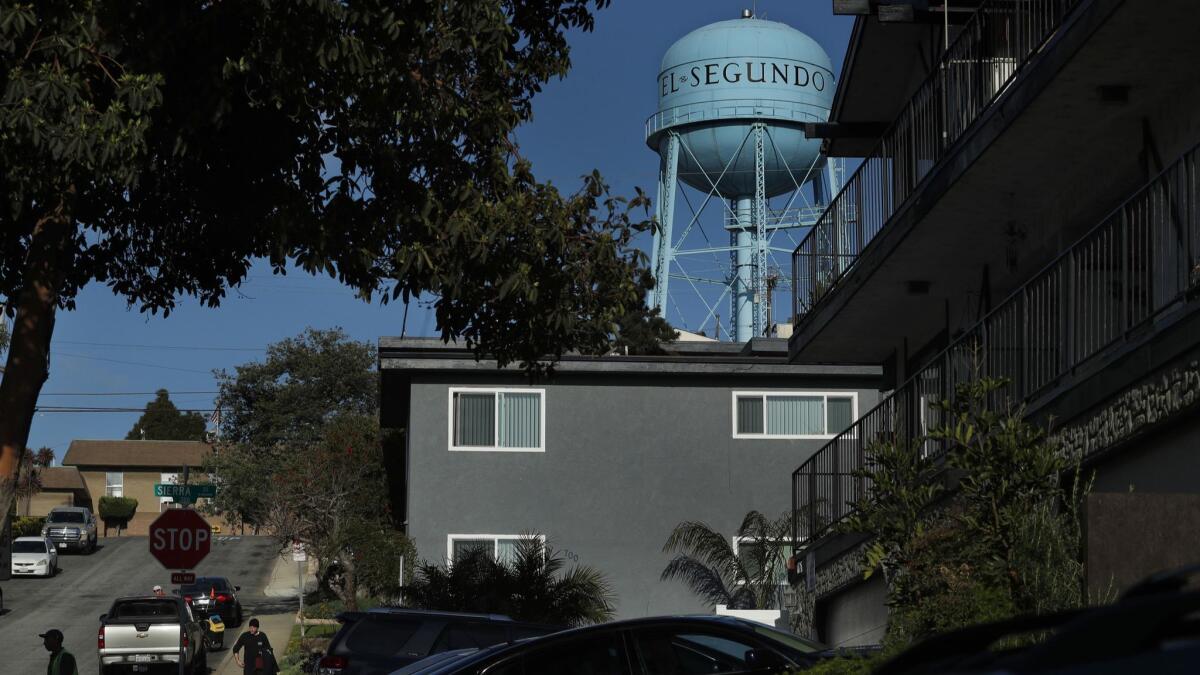Column: Spanish names, cultural shifts and a lot of L.A. linguist confusion. El Se-gun-dough or El Say-goon-dough?

L.A. Times columnist Steve Lopez takes to the street of El Segundo, the new home of the Los Angeles Times, to see how the locals pronounce it. Is it El Se-gun-dough, or is it El Say-goon-dough?
At the Blue Butterfly coffee shop on Main Street, two baristas had quick answers when asked how to say El Segundo.
“El Se-gun-dough,” said Del Elder.
“El Say-GOON-dough,” said Elias Garcia.
To argue his case, Elder pointed to his shirt, which said “The Gundo.”
“The gun-dough,” he said, enunciating clearly.
“How do you know it’s not GOON-dough?” asked Garcia.
Jonathan Hanks, another barista, had his own take.
“I say, ‘the gun-dough,’ but I say, ‘El Say-goon-dough,’ ” he said.
As you may have heard, the L.A. Times, headquartered in downtown Los Angeles for more than a century, is planning to move to El Segundo. In all the office chatter, I noticed that most of my colleagues said “gun” while others said “goon.” Then there’s the hybrid pronunciation in which the second syllable is Seh rather than Say, so you get El Seh-GOON-dough.
So I asked local historians, a linguist, my Cal State L.A. students and residents of El Segundo which way is right — not that there’s necessarily a right or wrong.
What followed was an exploration of how the pronunciation of place names became Anglicized in California, where cultural evolution and local customs make for differences over how to say Paso Robles, Los Feliz and San Pedro, among many other towns.
Let me start with my students, most of whom speak Spanish, and all of whom said the proper pronunciation is El say-GOON-dough.
OK, I said, what about Redondo?
A lot of them gave me the Anglicized pronunciation.
So why is it El Say-GOON-dough, but Ree-dawn-dough rather than Ray-doan-dough?
“It just is,” said one student.
Long before the Lakers and Kardashians arrived, saber-toothed cats roamed Los Angeles, which in the last 10,000 years or so has been home to the Chumash, the Tataviam, the Tongva and others. The Portuguese stopped by, the Spanish moved in, Mexico took over and then the U.S. snagged California in the late 1840s.
Pamela Munro, a UCLA professor emeritus of linguistics, said Topanga, Cahuenga and Tujunga are Tongva names, and guess what? “They’re all mispronounced by Angelenos, according to Tongva pronunciation,” Munro said.
The problem is the hard “G,” she said. She told me to say the name “singer.” The softer “G” was the correct pronunciation, she said, back in the day.
Local historian Nathan Masters, host of the TV show “Lost L.A.,” said Los Angeles had a rapid transformation after it became part of the United States in the middle of the 19th century. It went from majority Latino to majority white as the railroad extended west and people resettled here from all over the country and Europe.
“You had streams of migratory people here with no facility for the Spanish language,” said Bill Deverell, author of “Whitewashed Adobe: The Rise of Los Angeles and the Remaking of its Mexican Past.” Those newcomers no doubt wrestled with Spanish words and did their best phonetic pronunciations, which became the norm, perhaps with a boost from music, movies and popular culture.
So at some point, Sonn-Fair-NON-dough, named for the King of Spain, became San Fer-NAN-dough. And El Pueblo de Nuestra Senora de Los Angeles de Porciuncula became Los Angeles, which was much shorter but still created such confusion, there were campaigns to get everyone on the same page.
In 1880, the Chamber of Commerce claimed:
The Lady would remind you, please
The name is not Lost AN-jie-lees
A few decades later, the L.A. Times ran a box telling everyone the proper pronunciation went like this:
Loce AHNG-hayl-ais.
But El Segundo has a different history. It wasn’t named for a rancho, a king or a saint. As my columnizing cohort Robin Abcarian explained, Standard Oil executives arrived in 1911 in search of a site for a second California oil refinery. The one in Richmond was called El Primero, for first, and the site of the second became known as El Segundo.
Mary Jane Crafton and Karin Proell, a tennis doubles team, had just finished a game in the lovely park that sits in the center of El Segundo when I asked the name of their town.
“El Se-gun-dough,” said Crafton.
“El Say-GOON-dough,” said Proell.
Dora Gregg Lizagarra and Darlene Mackay sat with their grandchildren at a park picnic table, and they had the same cordial difference of opinion. Mackay, who says El-Se-gun-dough, told me she hears it both ways and she’s fine either way.
Rick Martin, who was watching his grandchild, straddled no fence. He said he was raised in El Se-gun-dough, went to El Se-gun-dough High School and has never heard anybody who was born and raised in El Se-gun-dough pronounce it any other way.
No doubt, one big factor in the preferred pronunciation is that El Segundo is about 80% white and 11% Latino.
“Sometimes I feel silly saying El Say-GOON-dough because nobody else does,” said Ashley Frazier, who speaks a bit of Spanish and enjoys working on it with friends. “But I know it’s a Spanish word, and it requires that pronunciation.”
But how many of us, even if we know some Spanish, say Sawnta-MOE-nica, or Air-Mosa Beach, or Ray-DOAN-dough Beach?
Or Loce AHNG-hayl-ais?
I think most of us rely on our primary language, or we mix it up a little bit, with no particular rules and maybe a little bit of confusion in the land of a thousand cultures.
If you’re hungry for Vietnamese, do you order pho or phuh?
I travel through Camarillo and Ventura rather than Comma-reeyo and Vain-tura, but I order chilaquiles con huevos revueltos, and I don’t have an explanation for any of that.
Is Calle Mayor (Main Street in Spanish), the boulevard that runs through Torrance, Cally Mayor or Kai-yay My-yore?

Depends on who you ask. Or is it whom?
Thanks be to Dios for Dos Equis beer and guacamole, which made all of us somewhat bilingual or at least Spanglish-adjacent — although there’s still the question of whether guacamole rhymes with holy.
El Segundo Mayor Suzanne Fuentes told me she is a Latina and fifth-generation Angeleno who grew up in a town she has pronounced one way her entire life.
“It’s El Se-Gun-dough,” she said firmly, and she assured me that in her home town, that is precisely how El Sugundans say it. There are, in fact, no El Segoondans.
Fuentes escorted me to the police department, where acting Capt. Jeffrey Leyman hit the GUN pronunciation real hard, leaving no doubt. Then we went to the fire department, where Spanish-speaking firefighter Jose Zambrano said he goes with El Se-gun-dough, even when he speaks in Spanish.
Some people mash the syllables, said Fuentes, and go with Elsa-gun-dough.
Councilman Don Brann, an outlier and rebel, has his own thing.
He calls it El See Gun Dough.
At the shopping center on the corner of Mariposa and Center, a guy named Chris was doing his laundry next to a guy named Naisoro Navi, who’s from Fiji, and both told me it’s El Say-Goon-dough. So did Jose Mendez, owner of La Paz Mexican Restaurant, which was filled with kids just out of El Segundo Middle School ordering French fries and quesadillas (nobody said Case-A-Dill-Uhs).
I do wonder, as whites become more of an ethnic minority in California, if we might slowly evolve back to the original pronunciations of some place names.
“The beautiful thing about language is that it always evolves, and pronunciations don’t have to be fixed,” said historian Masters.
In El Segundo, my last stop was at Village Liquor, where I asked owner Mark Samaan how he says the name of the town.
“Mayberry,” he said, “because nobody is out after 7 p.m.”
When several hundred of us move to the Gundo — or the Goondo — that could change.
Get more of Steve Lopez’s work and follow him on Twitter @LATstevelopez
More to Read
Sign up for Essential California
The most important California stories and recommendations in your inbox every morning.
You may occasionally receive promotional content from the Los Angeles Times.











